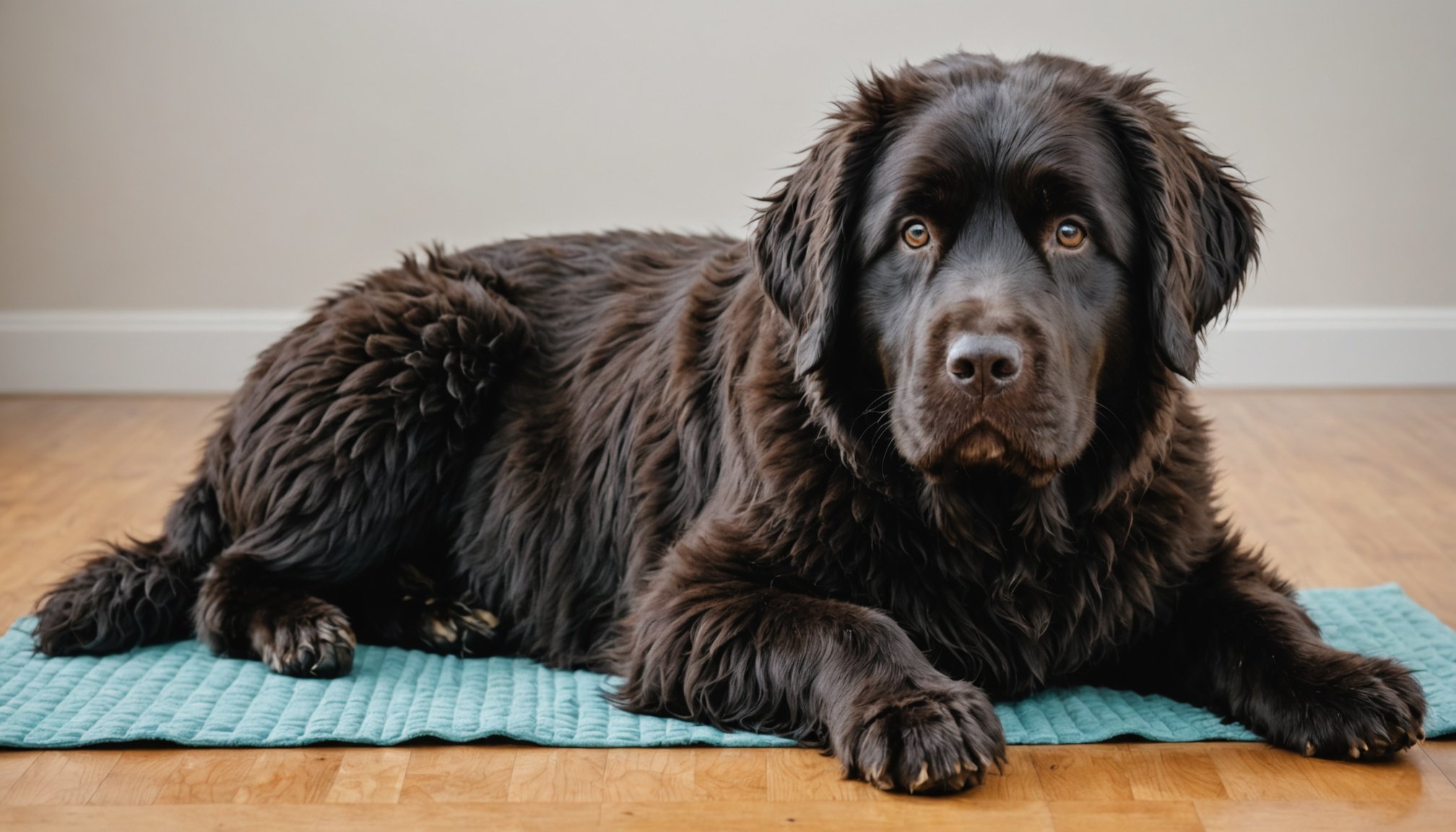Trimming your Newfoundland’s webbed feet is essential for their health, as it helps prevent infections that can arise from trapped debris and moisture. While maintaining your dog’s paws may seem daunting, it’s a manageable task with the right approach. This guide provides expert tips to ensure a safe and effective trimming experience, protecting your furry friend from discomfort and health issues. Equip yourself with the knowledge to keep those lovable paws in tip-top shape!
Importance of Grooming Newfoundland's Webbed Feet
Understanding the unique needs of Newfoundland dogs
Avez-vous vu cela : Essential Tips for Caring for Your Alaskan Malamute During Winter: Key Considerations for Pet Owners
Newfoundland dogs possess a distinctive anatomy, particularly their webbed feet, which are essential for their swimming prowess. Regular grooming of these feet is crucial to maintain their overall dog health. Neglecting foot care can lead to infections, a common issue among this breed.
Unique Anatomy of Newfoundland Dogs
What makes Newfoundland dogs special
Lire également : Essential Nutritional Guide for Pregnant Great Danes: Meeting Their Unique Dietary Needs
The webbed feet of Newfoundland dogs are a remarkable feature, enabling them to be excellent swimmers. This unique structure, however, requires special attention. Regular grooming helps in maintaining the health of their feet and prevents potential problems.
Importance of Regular Foot Grooming
Ensuring a healthy life for your Newfoundland
Routine grooming of a Newfoundland's feet involves cleaning and inspecting for debris or foreign objects. This practice is vital to prevent infections, which can arise from trapped moisture or dirt. Regular checks ensure that any potential issues are identified early.
Common Foot Issues
Challenges faced by Newfoundland breeds
Newfoundland dogs may face several foot-related problems. These include infections, fungal growth, and injuries from rough terrain. Addressing these issues promptly through proper grooming can significantly enhance your dog's health and well-being.
- Webbed feet
- Infections
- Regular grooming
Maintaining your Newfoundland’s foot care is a proactive step towards ensuring their happiness and longevity.
Tools Needed for Trimming Webbed Feet
Equipping yourself with the right grooming tools
Essential Grooming Tools
Investing in the right grooming tools is crucial for maintaining your Newfoundland's webbed feet. A good set of nail clippers and dog scissors are indispensable. These tools help you trim excess hair and nails, preventing debris accumulation and discomfort for your pet.
Recommended Types of Clippers and Scissors
When selecting nail clippers, opt for types specifically designed for large breeds. Guillotine clippers are popular, but scissor-style clippers provide better control. For dog scissors, choose ones with rounded tips to avoid accidental cuts. These tools should be sharp to ensure clean cuts, reducing stress for your Newfoundland.
Safety Features to Look for
Prioritize safety features in your grooming tools. Look for clippers with a safety guard to prevent cutting too deeply, which can cause pain or bleeding. Ergonomic handles are also beneficial, offering comfort and control during grooming sessions.
- Nail clippers with safety stops
- Dog scissors with rounded tips
- Ergonomic handles for ease of use
Selecting the right grooming tools not only ensures your Newfoundland's comfort but also enhances the grooming experience, making it safer and more efficient for both you and your pet.
Step-by-Step Guide to Trimming Webbed Feet
Mastering the art of dog grooming for your Newfoundland
Preparing Your Dog for Grooming
Creating a calm environment is essential for successful foot trimming. Begin by choosing a quiet space and gather all necessary grooming tools. Introduce your dog to the tools, allowing them to sniff and become familiar. Use calming techniques such as gentle petting or soothing words to ease anxiety. A relaxed Newfoundland will make the trimming process smoother and more effective.
The Trimming Process
Start by inspecting the webbed feet for any debris or foreign objects. Use dog scissors to carefully trim the fur between the pads, ensuring not to cut too close to the skin. Nail clippers should be used cautiously to trim the nails, avoiding the quick. Remember, maintaining a steady hand is crucial. Regular foot trimming not only keeps your Newfoundland comfortable but also prevents potential injuries.
Post-Trimming Care
After completing the trimming process, check the feet for any signs of irritation or injuries. Clean the area with a gentle antiseptic if necessary. Reward your dog with treats and praise to reinforce positive behavior during grooming sessions. This routine ensures your Newfoundland's feet remain healthy and well-maintained, enhancing their overall health and happiness.
Safety Precautions During Grooming
Ensuring your Newfoundland's comfort and safety
Preventing Cuts and Nicks
Grooming safety is paramount when trimming your Newfoundland's webbed feet. To prevent cuts and nicks, ensure your grooming tools are sharp and well-maintained. Dull blades can pull at the fur, causing discomfort. Maintain a steady hand and use a gentle touch to avoid injuring your pet.
Importance of Technique and Grip
Utilizing the right technique and grip is crucial in dog care. Hold the nail clippers and dog scissors firmly but gently, ensuring you have full control. Position yourself comfortably to maintain a stable posture throughout the process. This minimizes the risk of accidents, enhancing both grooming safety and efficiency.
Recognizing Stress and Discomfort
Understanding your dog's signals is vital to prevent injuries. Look for signs of stress or discomfort, such as whining, pulling away, or excessive licking. If these occur, pause the session and comfort your dog. A relaxed pet is key to a successful grooming experience.
- Ensure tools are sharp
- Maintain steady hand
- Recognize stress signals
By prioritizing grooming safety, you can create a positive environment that ensures your Newfoundland's well-being and makes the grooming process enjoyable for both of you.
Signs of Potential Infections in Dog Feet
Monitoring your dog's health through foot hygiene
Common Symptoms of Foot Infections
Recognizing the infection signs in your dog's feet is crucial for maintaining their dog health. Common symptoms include redness, swelling, and an unusual odor around the paws. You may also notice your dog licking or chewing their feet excessively, which can be a clear indicator of discomfort or pain.
Performing a Foot Health Check
Regular foot hygiene involves a thorough examination of your dog's feet. Begin by gently spreading the toes to inspect for any debris or foreign objects. Look for signs of irritation or cuts. Ensure the skin between the toes is free from redness or swelling. This routine check can help in early detection of any potential infection signs.
When to Seek Veterinary Advice
If you observe persistent symptoms or if your dog's condition worsens, it is essential to seek veterinary advice. Delaying treatment can lead to more severe health issues. A veterinarian can provide a comprehensive assessment and recommend appropriate treatment to ensure your dog's dog health.
- Redness and swelling
- Unusual odor
- Excessive licking
By staying vigilant and monitoring for these infection signs, you can take proactive steps to maintain your dog's overall foot hygiene and health.
Maintaining Foot Hygiene Between Grooming Sessions
Ensuring consistent care for your Newfoundland's paws
Daily Cleaning Practices
Incorporating a daily dog care routine is essential for maintaining optimal foot hygiene. After each walk, inspect your Newfoundland's webbed feet for any debris or irritants. Use a damp cloth to gently clean between the toes, removing dirt and moisture that can lead to infections. Regular cleaning helps in preventing the buildup of harmful substances.
Best Products for Cleaning and Moisturizing
Selecting the right products is crucial for effective foot hygiene. Opt for pet-safe wipes or sprays designed for cleaning dog paws. These products often contain mild antiseptics and moisturizers, ensuring the skin remains healthy and hydrated. Consider using paw balms to add an extra layer of protection, especially during harsh weather conditions.
- Pet-safe wipes for gentle cleaning
- Moisturizing balms for added protection
- Antiseptic sprays to prevent infections
Importance of Checking for Debris and Irritants
A thorough check for debris and irritants after walks is vital in your dog care routine. Small stones, thorns, or plant material can easily lodge between the toes, causing discomfort or injury. By routinely examining your dog's feet, you can promptly address any issues, ensuring their comfort and well-being. Regular attention to foot hygiene promotes a healthy and active lifestyle for your Newfoundland.
When to Consult a Veterinarian
Ensuring optimal care for your Newfoundland's foot health
Situations Warranting Veterinary Care
Certain health concerns necessitate immediate veterinary care for your Newfoundland. Persistent symptoms like swelling, redness, or unusual odors around the feet are clear indicators. If your dog exhibits discomfort or pain despite regular grooming, a veterinarian's expertise becomes crucial. They can diagnose underlying issues that may not be visible to the untrained eye.
Benefits of Professional Grooming
Engaging in professional grooming offers numerous advantages for your Newfoundland's foot health. Groomers are skilled in handling large breeds and can effectively manage the intricate needs of webbed feet. They provide thorough cleaning and trimming, reducing the risk of infections or other health concerns. Regular visits to a professional groomer can complement your home care routine.
Veterinary Assistance with Foot Health
Veterinarians play a vital role in maintaining your dog's health concerns related to their feet. They offer specialized treatments and advice tailored to Newfoundland dogs. Regular check-ups ensure any potential issues are addressed promptly. A veterinarian can also recommend appropriate products for maintaining foot health between grooming sessions.
- Persistent symptoms: swelling, redness, odor
- Professional grooming: thorough cleaning, trimming
- Veterinary advice: specialized treatments, product recommendations
Consulting a veterinarian ensures your Newfoundland's feet remain healthy, promoting their overall well-being.
Visual Aids and Resources for Dog Owners
Enhancing your dog care knowledge through visual learning
Importance of Visual Aids in Understanding Grooming Techniques
Visual aids play a crucial role in mastering grooming techniques for Newfoundland dogs. They provide clear demonstrations, making complex tasks more accessible. Watching a grooming video can offer insights into the nuances of handling webbed feet, ensuring you perform each step correctly. Instructional images complement these videos by highlighting specific angles and positions, enhancing your understanding.
Recommended Video Tutorials and Online Resources
For dog owners seeking guidance, a wealth of grooming videos and online resources is available. These tutorials often feature professional groomers sharing expert tips on maintaining foot hygiene. Engaging with these resources can boost your confidence and improve your skills in dog care. Look for videos that focus on large breeds, ensuring the content is relevant to your Newfoundland's needs.
Community Forums and Support Groups for Dog Owners
Connecting with other dog owners through community forums and support groups provides additional support. These platforms allow you to share experiences, ask questions, and gain advice on grooming techniques. Engaging with a community can offer reassurance and practical solutions, making the grooming process more manageable and enjoyable.
- Grooming videos for step-by-step guidance
- Instructional images for detailed views
- Community forums for shared experiences
By utilizing these resources, you can enhance your grooming skills and ensure your Newfoundland's feet remain healthy and well-maintained.
Summary of Key Takeaways
Reflecting on essential practices for Newfoundland care
Recap of Grooming Importance
Understanding the significance of dog grooming tips is essential for maintaining your Newfoundland's foot health. Regular grooming prevents infections and ensures the well-being of their webbed feet. Prioritizing these practices helps in avoiding potential health issues.
Safety Measures in Grooming
Adhering to safety measures is crucial during grooming sessions. Use sharp tools to avoid discomfort and maintain a steady grip to prevent accidents. Recognizing signs of stress in your dog can make the process smoother and safer.
Final Tips for Maintaining Webbed Feet
- Inspect regularly for debris and irritants
- Use appropriate grooming tools with safety features
- Maintain a calm environment during grooming
These final tips ensure your Newfoundland's feet remain healthy and comfortable.
Encouragement for Ongoing Learning
Staying informed about Newfoundland care is vital. Engaging with community forums and online resources enhances your knowledge of effective dog grooming tips. Continuous learning supports vigilant care, ensuring your Newfoundland's foot health is always a priority.
By implementing these practices and remaining proactive in their care, you can significantly contribute to your Newfoundland's overall health and happiness.






